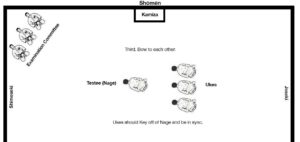I was telling some friends about my upcoming Sandan test a few weeks ago and they asked me a question that I had never honestly thought about, “Why are you testing for Sandan? What do you get from it?” To really answer that question, I need to start from the beginning – discuss why I started Aikido, what’s changed, and what keeps me coming back.
When I started Aikido in 2006, my primary goal was fitness. I get bored easily at the gym, but I thought that if I started a martial art, I could be active and mentally engaged – learning at the same time. I chose Aikido because there wasn’t any competition (I wasn’t interested in having the extra stress of “making weight for the upcoming match”; I was only interested in self-improvement) and it had a reputation for being difficult to become proficient at…it was something that I knew would keep me engaged for at least the next 5+ years. On my first visit, I knew Aikido of Charlotte was the right dojo for me and I’ve been there ever since (14 years now).
My first training goal, in addition to the more general goal of improving fitness, was black belt (Shodan). In the first weeks of starting Aikido, I had all of the time requirements mapped out to figure out when I could take all of my tests until Shodan and I went to absolutely every class. As a 22 year old new college graduate with my first grown-up job, it seemed like I had more money and free time than I knew what to do with. As time passed however, I realized two things: that counting down the days until my next test wasn’t an important milestone for my training and progression and that the biggest challenge to training wasn’t the difficulty of the techniques, but the way that life outside of the dojo constantly changes.
My struggle became, and still exists today, balancing dojo time with the increasing responsibilities of life. Personal relationships, increasing work responsibilities and travel, home maintenance – all of these became additional ukes in the randori of life. The dojo too, over time, became less a recreational activity and more of a responsibility. I don’t want responsibility to sound negative; it’s positive in every sense. But as one advances in the dojo, your training focus, I found, becomes less about yourself and more about the dojo…it becomes about helping your kohai learn the lessons you’ve learned along the way and it becomes helping your sempai prepare for their tests, or helping them teach, or eventually teaching yourself. I realized that becoming a Shodan was less about being good at martial arts and more about being devoted to the advancement of the art of Aikido. That advancement includes personal improvement AND improvement of the dojo. The goal of working out and being active is still there and being achieved, but that is only a small part of the totality of Aikido training.
After achieving Shodan and continuing on the road through Nidan and Sandan; I came to view my personal rank promotions not as “rank” per se, but as re-affirmations of my commitment to Aikido. The higher ranks bring with them more responsibility to the dojo/more responsibility to Aikido. It’s not about proving who’s best, but I view it as a symbol of what I’ve learned from my sensei and sempai and as a commitment to my kohai going forward. The difficulty of balancing all of this will only increase, but so will my ability in balancing it and my commitment to doing it.
5 Questions with our Chief Instructor – Part 2
5 Questions with our Chief Instructor – Part 2 Jared Heintz: Aikido is often praised for its applicability in self-defense situations. Could you discuss how Aikido techniques can be adapted to real-world scenarios, and what mindset one should cultivate in such situations? Weiner Sensei: As I approach 25 years of Aikido practice, I’ve realized that…
Rank Testing Bowing Reiho – Advanced
Rank Testing Bowing Reiho – Advanced Andy Demko Shihan likes to say, “The little things don’t mean a lot, they mean everything”. Everyone who has practiced in our dojo or visited has seen that we take Reiho (Etiquette) pretty seriously. In all that we do, practice. Bowing. Addressing each other & more. I learned a…
Sensei
Sensei 先生 The two characters that make up the term can be directly translated as “born before,” and imply one who teaches based on wisdom gained from age and experience. In general usage, it is used, with proper form, after a person’s name and means “teacher.” In Japan, the word is also used as a…




